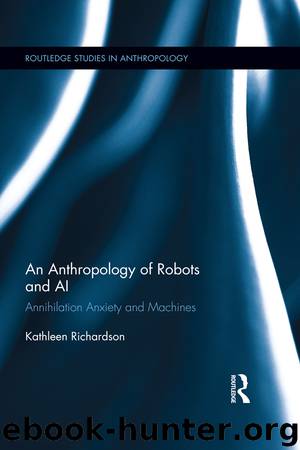An Anthropology of Robots and AI by Richardson Kathleen

Author:Richardson, Kathleen. [Kathleen Richardson]
Language: eng
Format: epub
ISBN: 9781317566946
Publisher: Taylor & Francis (CAM)
Social Relational Robots
Robotic researchers are interested, then, in the social dynamics that take place when social bodies interact. They focus on aspects of the body that emphasize communicative interaction, such as the importance of specific bodily parts; among these are eyes and general body shape that mimic human bodies and hands.
The robots Radius and Marius were built with these types of bodily communicative specifications in mind. The construction of the body is one step towards modeling a socially interactive body. Human bodies carry within them information about communication. That is to say, they are given a familiar socially interactive framework within which to operate. A human body form carries with it certain expectations about both its behavior and performance. The simple behaviors of nodding the head, pointing a finger, looking in a similar direction, orienting body direction, smiling, frowning and tilting the head to one side, pulling back the head and raising the eyebrows all demonstrate cooperation, shared interest, approval or dislike, surprise, and curiosity. In the absence of any sophisticated behaviors, many types of “interior” states or “relational” states can be communicated by a robot’s behavior. Researchers at MIT went one step further than this mere puppetry by attempting to engage a human in a communicative behavior-based dialogue with a machine. This was most notably done by the robot Kismet, the creation of Cynthia Breazeal and several of her colleagues at the MIT AI Lab.
The robot Kismet was an example of a sociable robot, and the first of its kind designed by the former AI Lab at MIT. Kismet was a research platform and had a head with facial movements that mimicked human expressions such as being angry, bored and happy. It had a limited number of facial movements that enabled it to mimic these basic human emotions. The inspiration for Kismet was drawn from Rodney Brooks’ model of behavior-based robotics. Kismet was to behave in such a manner that it could communicate emotion through facial expressions and bodily movements (the bodily movements confined to the head). If a robot is to perform sociable interactions, it needs the same physical parts that humans also use in the same interaction. Kismet mimicked human behaviors, yet the sociable repertoire of Kismet was not exclusively human—it also mimicked common animal behavior, such as showing fear by withdrawing. Kismet’s technology was simple, yet extremely effective. Kismet had a series of drives that regulated its patterns of interactions with human interlocutors. These “drives” were randomly ordered and, by altering its behaviors, Kismet may appear happy or sad or interested. As the drives were randomly ordered, Kismet could move from one drive to another. The makers added another element to Kismet: they made Kismet responsive by deploying senses to help it choose appropriate drives/emotions for a situation. If Kismet was interacting with an interlocutor, the behavior of the interlocutor could influence the sociable-emotional responses of Kismet. This depended on one’s proximity to and interaction with Kismet for it to alter its emotional arrangements. It would
Download
This site does not store any files on its server. We only index and link to content provided by other sites. Please contact the content providers to delete copyright contents if any and email us, we'll remove relevant links or contents immediately.
Whiskies Galore by Ian Buxton(41941)
Introduction to Aircraft Design (Cambridge Aerospace Series) by John P. Fielding(33094)
Small Unmanned Fixed-wing Aircraft Design by Andrew J. Keane Andras Sobester James P. Scanlan & András Sóbester & James P. Scanlan(32766)
Craft Beer for the Homebrewer by Michael Agnew(18199)
Turbulence by E. J. Noyes(7981)
The Complete Stick Figure Physics Tutorials by Allen Sarah(7339)
Kaplan MCAT General Chemistry Review by Kaplan(6903)
The Thirst by Nesbo Jo(6882)
Bad Blood by John Carreyrou(6584)
Modelling of Convective Heat and Mass Transfer in Rotating Flows by Igor V. Shevchuk(6408)
Learning SQL by Alan Beaulieu(6239)
Weapons of Math Destruction by Cathy O'Neil(6220)
Man-made Catastrophes and Risk Information Concealment by Dmitry Chernov & Didier Sornette(5957)
Digital Minimalism by Cal Newport;(5706)
Life 3.0: Being Human in the Age of Artificial Intelligence by Tegmark Max(5518)
iGen by Jean M. Twenge(5387)
Secrets of Antigravity Propulsion: Tesla, UFOs, and Classified Aerospace Technology by Ph.D. Paul A. Laviolette(5335)
Design of Trajectory Optimization Approach for Space Maneuver Vehicle Skip Entry Problems by Runqi Chai & Al Savvaris & Antonios Tsourdos & Senchun Chai(5039)
Pale Blue Dot by Carl Sagan(4960)
